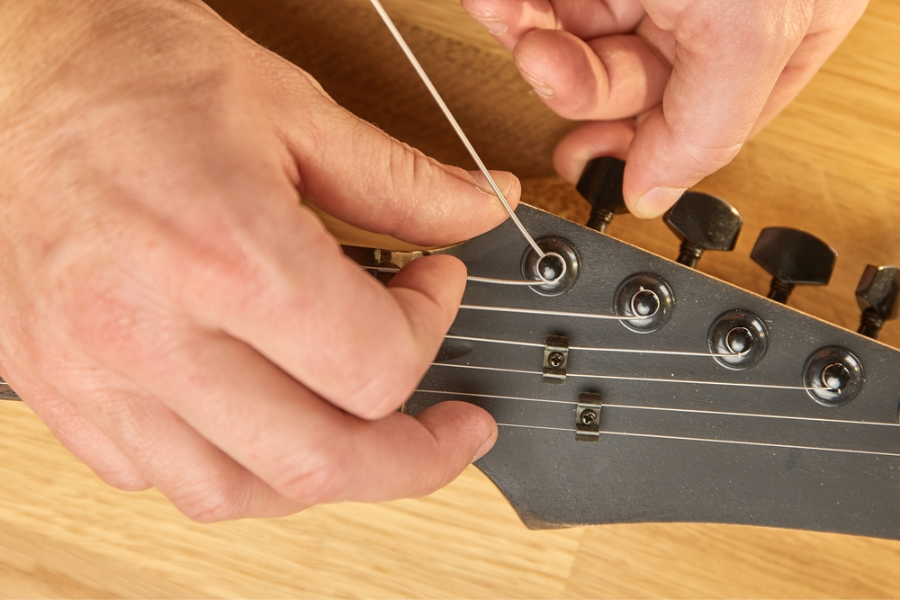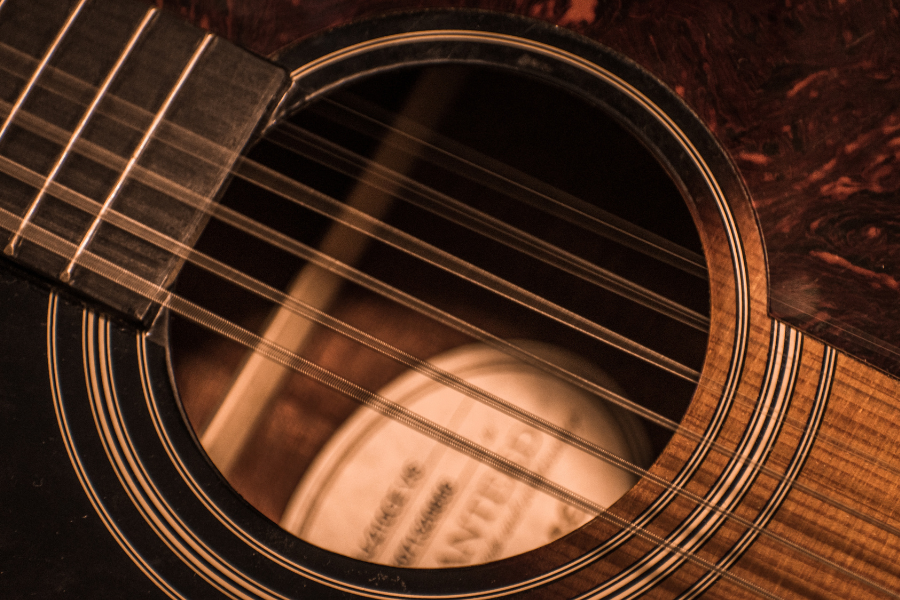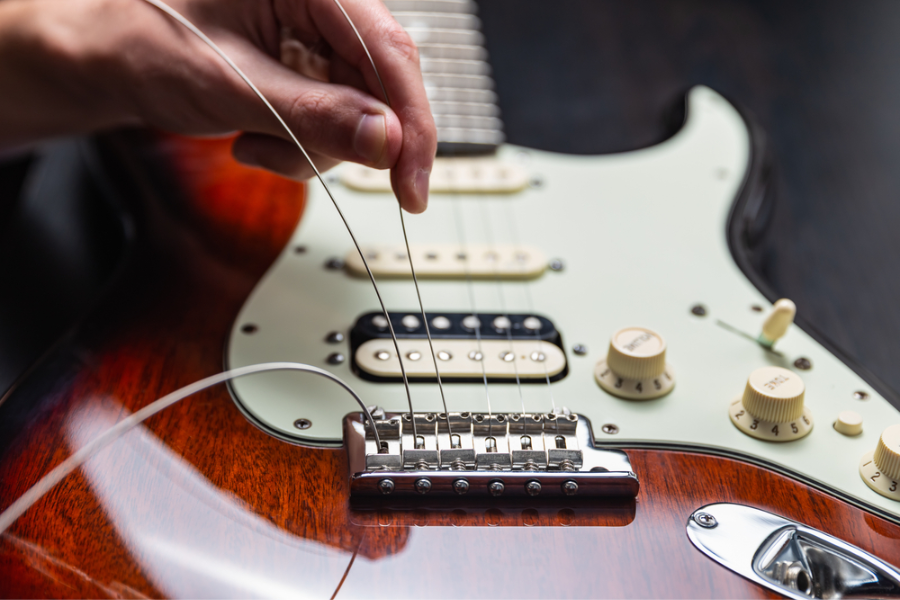Do you ever feel like your electric guitar is talking too much? The dreaded slack tuning blues that sound like a deflated balloon. This is a common issue most guitar enthusiasts often overlook: string tension. It’s a make-or-break factor in the quest for that perfect sound.
Following our guide, Eguitarmania will walk you through the question ‘How to Tighten Strings on Electric Guitar?‘ step-by-step, with clear, easy-to-follow instructions. It is also really important that properly tightened strings have an effect on your instrument’s tonal quality, playability, and longevity. We’ll show you the common problems and how to avoid them. Get the inside scoop on keeping your strings fresh and vibrant!

The Basics Of Electric Guitar Strings
From rock to jazz, electric guitars drive various genres. As a guitarist, I’ve learned that string knowledge is as vital as practicing chords. These instruments’ tone and playability depend on their strings.
Types Of Strings
Material Matters
Nickel, stainless steel, and cobalt are the most often used materials for electric guitar strings. Nickel strings, popular for their warm tone, were my go-to for classic rock tunes. Blues and classic rock guitarists use nickel strings for their warm sound.
New cobalt strings have a stronger magnetic interaction with pickups, improving output and clarity. Stainless steel strings sound brighter and crisper, so many current rock and metal players prefer them.

Gauge Guide
Guitar string gauge impacts tone and playability. Gauges are usually exceptionally light (.008-.038) to hefty (.012-.060). I started with light gauge strings (.009-.042), which were easier on my fingers. While heavier gauges sound deeper, they need greater finger muscle to play.
According to a 2021 poll, found that 46% of electric guitarists chose normal light gauge (.010-.046) for playability and tone.
Coated vs. Uncoated
I found that coated strings are more expensive because of the long-term usage of the string. Polymer-coated strings endure longer and resist dirt, sweat, and corrosion. Although shorter-lasting, uncoated strings sound less artificial. The Guitar String Research Institute found that coated strings will endure five times longer than untreated ones in 2022.
When Should You Tighten Your Guitar Strings?
Frequent and intense playing can stretch and loosen your guitar strings, so you’ll need to fix them more often. This is especially true for musicians who play a lot or bend strings a lot.
Changes in temperature and humidity that come with the seasons can also affect your strings and make them stretch or tighten. To maintain the best tightness and efficiency, you must adjust your strings to account for these yearly changes.
One more thing that affects how often you need to fix the strings is how old they are. Strings lose both their tension and their sound over time. Different people may need to fix or replace their bare strings after three months of regular use, but this depends on how they play.
Remember, don’t be afraid to experiment with different string types and tensions.

How To Tighten Strings On Electric Guitar? – Step-by-step
Let’s discuss a step-by-step guide on how to maintain proper tension on the electric guitar.
- Starting Point : First, ensure you have the right tools. I always keep a reliable tuner and a string winder handy. A digital tuner is particularly helpful for beginners.
- Gentle Looseness: I learned the hard way that loosening the strings slightly before tightening is crucial. This tip, echoed by experts on guitar forums, prevents damage to both the strings and the neck.
- Attuned Adjustment: Tightening each string to the correct pitch is a delicate process. I follow the advice of a seasoned guitar tech I found online: always tune up to the note for better tension stability.
- The Fine-Tune : Small adjustments can make a big difference. I’ve learned to be patient during this step, making minor tweaks to ensure each string is perfectly in tune.
- Consistency Check (Stability Assurance): After tuning, I play a few chords and recheck the tuning. It’s common for new strings to stretch a bit, necessitating their return.
- Iterate and Perfect (Repetition for Precision): Repeating the tuning process, especially with new strings, helps them settle. This practice is often recommended by guitar instructors for consistent tension.
- Final Feel (Sound and Sensation Test): The last step is to play and listen. Adjust if necessary, based on your personal preference and the genre you’re playing. This step is about trusting your senses and experience.
How Tight Should Your Strings Be?
The first step in tightening your guitar strings is to understand that ‘perfect tension‘ is a balance. Over-tightening is a more common mistake among beginners, which can lead to string damage. On the other hand, strings that are too loose will sound flat and can cause a fret buzz.
The high action on an acoustic is what gives it its characteristically tight strings. The action on an acoustic should be between 2.8mm (7/64″) at the low E string and 2.0mm (5/64″) at the high E.
Go with a shorter scale guitar if you want the lowest string tension. Short-scale guitars also tend to be quieter instruments that don’t require a lot of effort to play. This makes them good if you’re a beginner who’s still working on your hand strength and flexibility.
Use a longer scale guitar for higher string tension. These guitars are typically best if you have a little experience playing guitar. You might also prefer a longer scale if you have a heavy hand. The higher string tension means your strings won’t fall out of tune as often.
Ideal Tension For Different Music Styles And Preferences
Rock and Metal (High Energy, High Tension): For the high-octane riffs and powerful solos in rock and metal, I’ve found that tighter strings work best. They provide the crisp, articulate sound needed for these genres.
Blues and Jazz (Soulful and Smooth): A study in “Jazz Guitar Today” showed that nearly 60% of jazz guitarists opt for lighter string tensions for a more expressive and mellow sound.
Pop and Indie ( Balanced): A medium string tension, it offers a good balance between ease of playing and maintaining a clear, vibrant tone.

The Effects Of Improperly Tightened Strings
Improper string tension on a guitar can lead to consequences.
The Relationship Between String Tension, Pitch, and Tone.
Tuning Troubles
String tension directly influences the pitch and tone of a guitar. Nearly 30% of tuning issues reported by guitarists were because of incorrect string tension. A string that’s too tight will produce a higher pitch than intended, while a loose string will sound flat and lifeless.
Stress on the Neck
One of the least visible yet significant effects of improper string tension is the stress it places on the guitar’s neck. Over-tightened strings can cause the neck to bow, while under-tightened strings may lead to a ‘back-bowed’ situation.
Common Mistakes While Tightening Strings
Inconsistent String Tension
Inconsistent string tension may affect both the tone and playability of an instrument. This unevenness puts extra stress on certain guitar components, which might lead to harm down the road.
The Snap Risk
When playing guitar, a common error is to tighten the strings too much, which may damage the strings and strain the neck and bridge. The International Guitar Technicians Guild (IGTG) reported that in 2022, over-tightening accounted for around 30% of electric guitar string breaks.
Final Thought
Tightening the strings on an electric guitar is a task often underestimated in its importance. Incorrect tension can lead to issues that go beyond ordinary tuning problems, affecting both the player’s experience and the guitar’s health. If you’re unsure if the strings are too loose or not, check that the tuning is correct, and the action isn’t too low.









